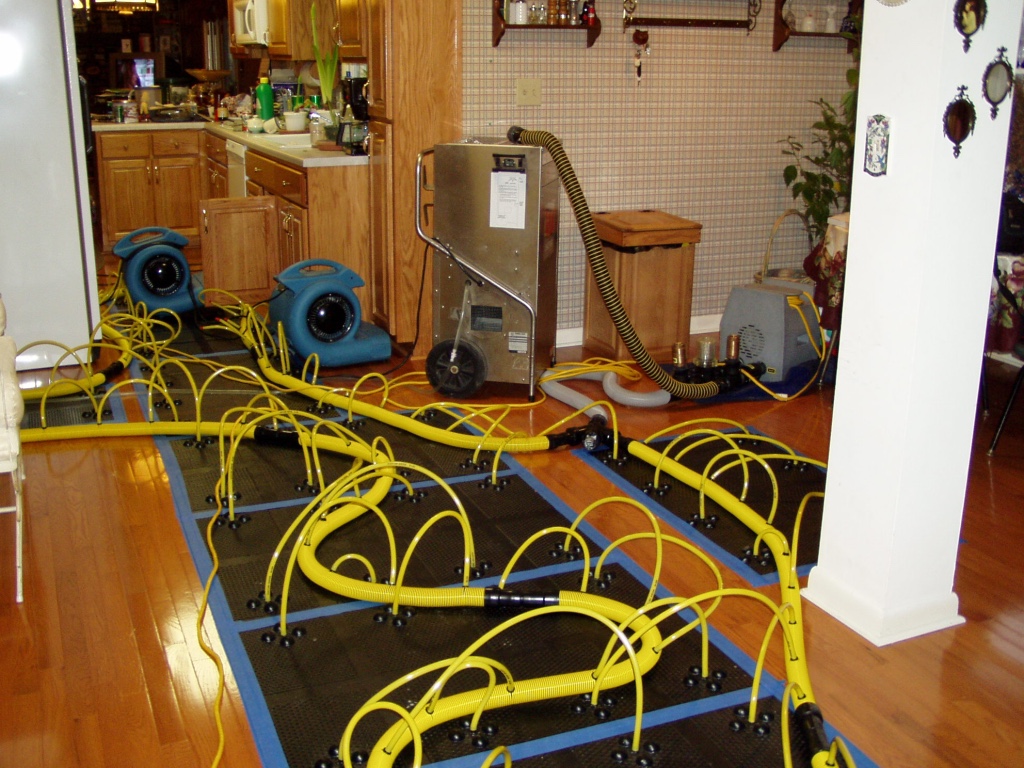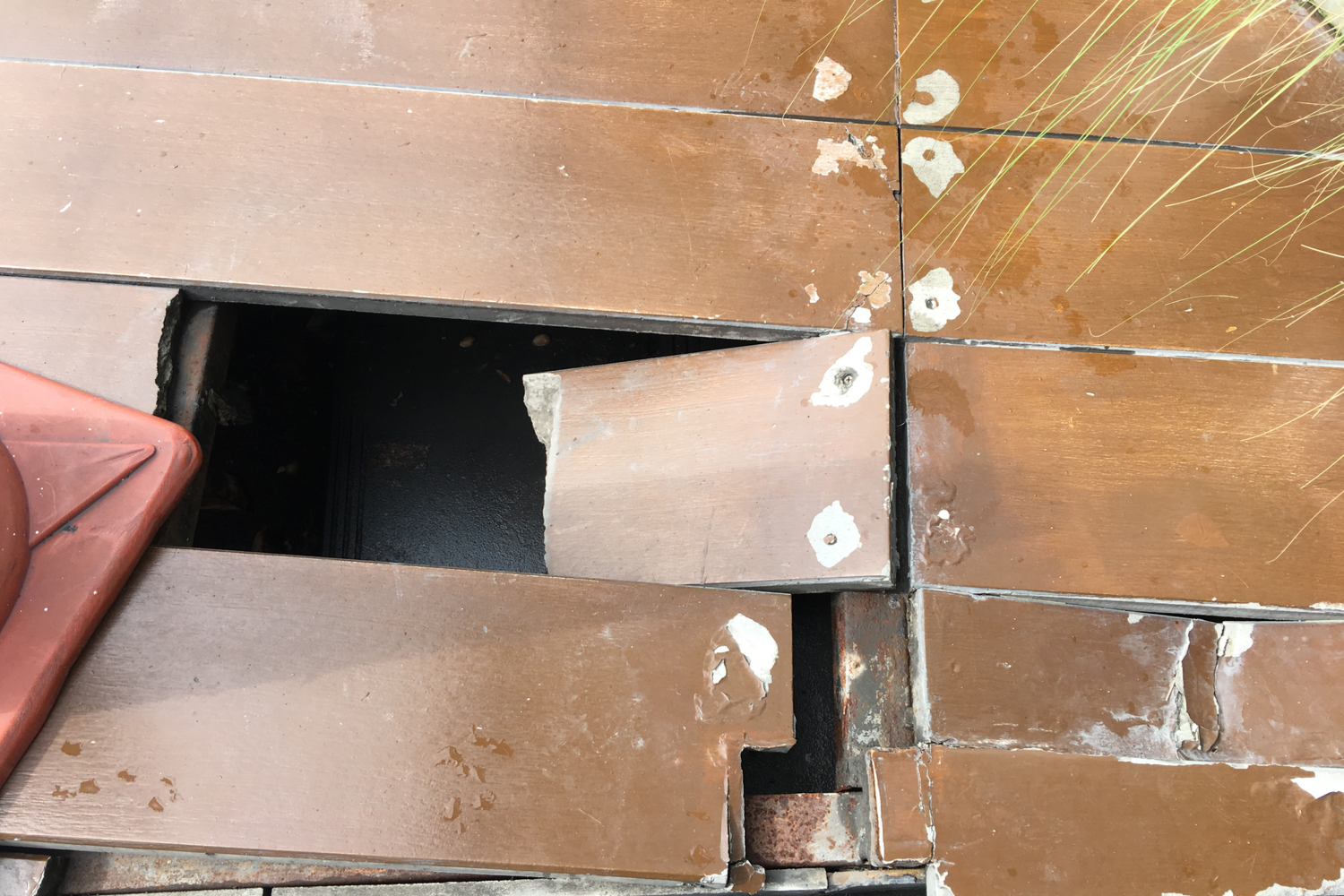Why Is My Floor Buckling?
Wood floors expand and contract throughout the year as the seasons, temperatures, and humidity conditions change. A wooden floor is always installed with this factor in mind. That is why your hardwood floor is never squeezed in edge to edge on every side of your room. Enough of a gap must be left to account for this expansion and contraction. If moisture, in the form of water damage or high humidity is added, the wood flooring will slowly absorb the moisture and begin to expand. When the expansion becomes severe, and the gap is closed, the floor may begin to buckle.
How can I identify Hardwood Floor Damage?
Moisture absorption by hardwood floors is a slow process. As the individual boards begin to take in more moisture they begin to slowly swell. This swelling can be seen as cupping; both edges of the board begin to rise, forming a u-shaped “cup”. Instead of being seen as smooth and flat, your floor will take on a wavy appearance.
In addition to expanding in thickness, as more moisture is absorbed, your floor will begin to expand side to side. As this occurs, the gap between the floor and the wall gets smaller and smaller until there is no more room for the floor to expand. That is when buckling will begin. As the boards cannot expand sideways anymore, they will be forced upward. Once this happens there is no saving the floor.
What types of Hardwood Floors can be Damaged by Water?
Water will damage any kind of hardwood flooring. Some flooring can be saved if the damage is found and corrected quickly, others cannot.
Solid Hardwood – solid hardwood is a single piece of wood, usually ¾” thick, that is installed, sanded, and finished onsite. These floors can be oak, maple, hickory, pine, or some other type of wood. They are the most resistant to water damage in that they absorb water very slowly and can be restored if the damage is addressed quickly enough.
Pre-Finished Solid Hardwood – pre-finished hardwood has been sanded and finished at the factory. They have a very durable finish and will resist water damage as well as solid hardwood. Their only downside is their finish may make them even harder to dry and sometimes damage to the finish is irreversible.
Engineered Hardwood – these are manufactured floors and the nature of the floor depends upon the materials used to produce them. Water will affect them in different ways depending the materials used. Restorers call these floors “was wood” because at one time the material was wood, now it is something different. When engineered wood floors are damaged by water they can be dried, but sometimes the finish is ruined and the floor requires replacement.
Laminate Floors – these floors are often damaged beyond repair by water. The problem is their top layer, the finished layer, is very thin and will warp when they become over-wetted. Also, many times there is a padding, or plastic barrier, that helps cushion the floor. Once water affects this padding there is no way to quickly remove the water without removing the floor and then removing the padding.
Luxury Vinyl Flooring – this flooring is extremely resistant to water damage. But that doesn’t mean that it can’t be damaged. When water affects these floors, they are usually carefully taken up, the subfloor and the vinyl planks are dried, then afterwards the vinyl planks can be reinstalled.
What kinds of Moisture can Damage my Floors?
Moisture buildup in flooring can occur quickly from a flooding situation, or slowly over time as the floor absorbs excess moisture. There main causes are:
-
Pipe leaks
-
Icemaker leaks
-
Dishwasher supply lines
-
The floor was installed on a wet subfloor
-
Humidity buildup
-
Lack of ventilation over a long period of time allowing humidity to increase
-
Installation errors (not leaving room for expansion)
How can I fix Floor Buckling or Damage?
Drying hardwood floors is a specialized and difficult task to accomplish. The water can only come out as slowly as it gets absorbed. Just drying a hardwood floor with towels and a household fan will not get the job done. The job requires specialized drying equipment.
At Water Mold Fire Restoration, we have everything that is needed to successfully restore a hardwood floor that has been damaged by water or excess moisture. But you need to respond quickly, before the floor actually buckles. Our floor drying experts will use specially designed extraction and drying equipment that will slowly return the floor’s moisture content to a safe level. Drying conditions must be monitored closely. Over-drying or drying a floor too quickly can be just as damaging as its exposure to the water to begin with.

Sometimes refinishing will be required after a floor is damaged by water. Sanding the floor before it is dried will result in permanent damage. If sanded while it is wet, once the floor finishes drying on its own (sometimes taking several months), what is known as “crowning” will be seen. Because the edges were still wet when the floor was sanded, the edges will be thinner than the board’s centers. Once the edges dry, with the centers thicker, you will be able to see the same waviness, but this time it will be because the centers of the boards are thicker than the edges. Re-sanding and refinishing will be needed to correct this and there may not be enough material remaining to compensate for the additional sanding. Replacement may then be your only option.
How can I prevent Floor Buckling?
Here are some preventative measures you should be aware of:
-
Quickly wipe up any spills that occur.
-
Try to prevent floor scratches or gouges, as these mars in the finish will allow water to be absorbed faster if a problem does arise.
-
Don’t wet mop or use steam to clean a hardwood floor.
-
Constantly be on the lookout for appliance leaks like icemakers, dishwashers, or washing machines.
Call Water Mold Fire Restoration at 800-905-0277 at the first sign of any hardwood floor damage in your home. The quicker you take action, the more likely it will be that the floor can be restored and not require sanding or refinishing. Many times after we are finished drying a floor, a light cleaning is all that will be required.








